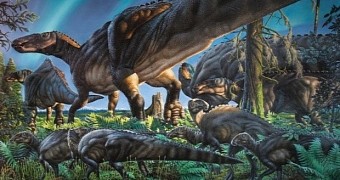A recent study in the journal Acta Palaeontologica Polonica announces the discovery of a previously undocumented dinosaur species in a remote corner of Alaska. The new species, dubbed Ugrunaaluk kuukpikensis, is the northernmost on record, explain researchers at Florida State University.
Living at such a high latitude, the creatures undoubtedly faced rather harsh weather conditions. Mind you, paleontologists suspect that, when winter came around, they spent many months in darkness. They probably even had to deal with snow every now and again.
Researchers have been debating whether dinosaurs were warm-blooded, cold-blooded or maybe something in between for many years now. The discovery of this previously unknown species in Alaska hints that these ancient creatures had some way to control their body's temperature on their own.
Otherwise, they would not have survived the extreme weather. “The finding of dinosaurs this far north challenges everything we thought about a dinosaur's physiology. It creates this natural question: how did they survive up here?” says researcher Greg Erickson.
The newly discovered dinosaurs were herbivores
Fossil evidence uncovered and analyzed by the Florida State University team shows that the newly discovered Ugrunaaluk kuukpikensis was a herbivore. A duck-billed dinosaur, it would grow to measure around 30 feet (9 meters) from head to tail.
Ugrunaaluk kuukpikensis fossilized remains have so far been recovered from sites along the Colville River, especially from a geological formation located in northern Alaska and dubbed the Prince Creed Formation, the paleontologists detail.
Nearly 70 million years ago, when this dinosaur species walked the Earth, the region was a flood plain covered in trees. The average temperature was about 43 degrees Fahrenheit (6 degrees Celsius). As mentioned, researchers suspect snow also happened.
Apparently, the Prince Creek Formation hides thousands of Ugrunaaluk kuukpikensis bones, most of which belong to juveniles. Paleontologists suspect the remains belong to a herd that was somehow lost all of a sudden, and so the animals ended up in a mass grave.

 14 DAY TRIAL //
14 DAY TRIAL // 